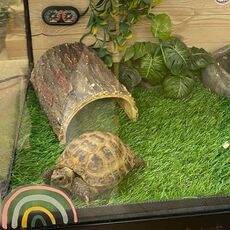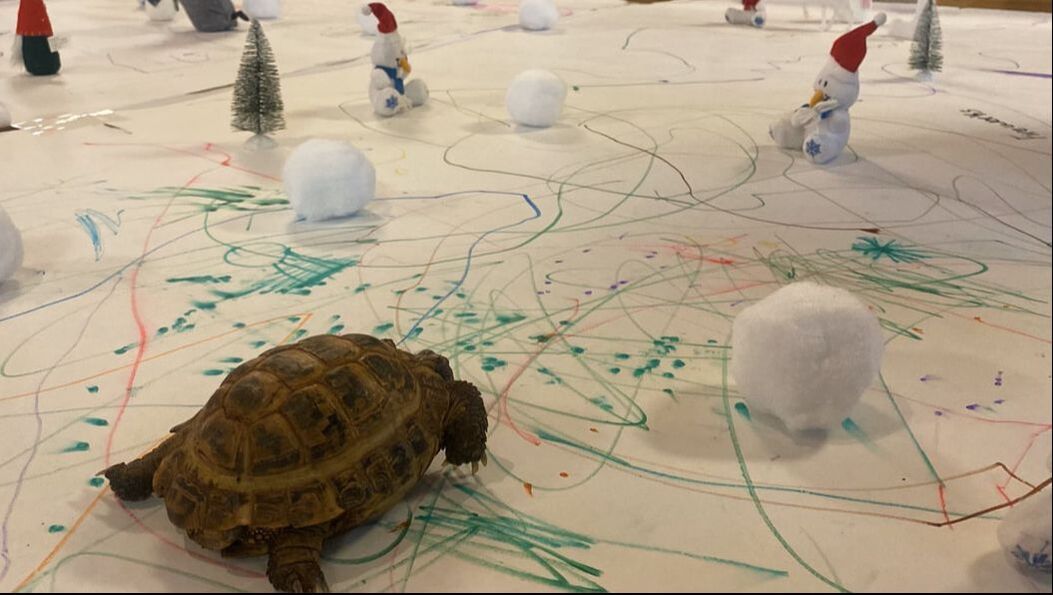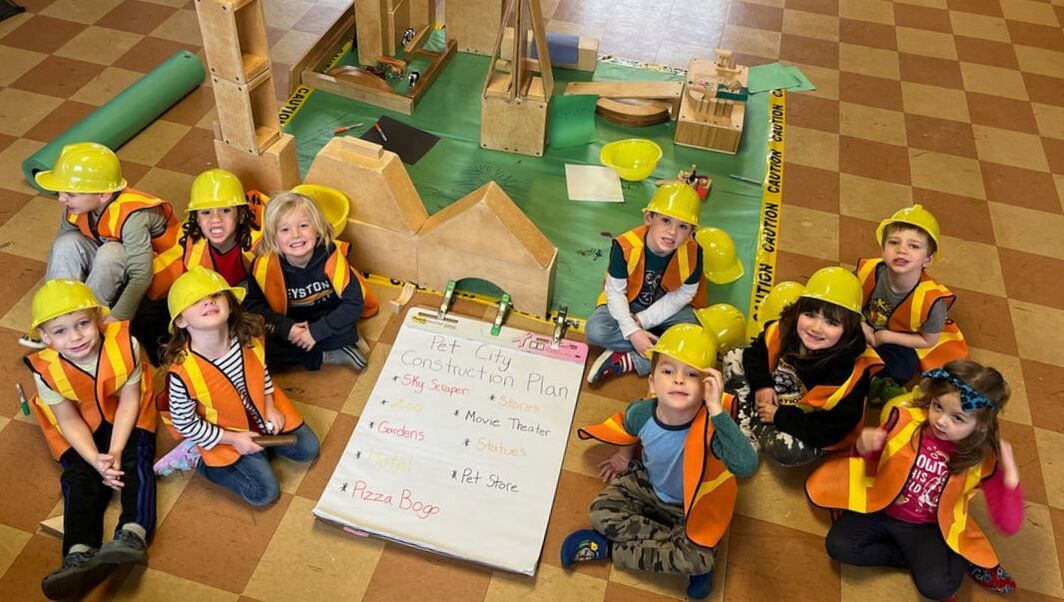|
As we get ready to begin our two week Travel theme, we are delighted to introduce a new member to our preschool family—Huddle the Traveling Rhino! Huddle is not just any stuffed toy; he's a special companion that has already embarked on exciting journeys with our School Director, Mx. Taryn. Huddle's story began during a visit to Massachusetts last summer when he crossed paths with Mx. Taryn, while they were home visiting family. Mx. Taryn stumbled upon Huddle at “owen and sage”, a charming local store. They were drawn to its unique selection for children and the delightful atmosphere created by the friendly staff. Since their “meetcute”, Mx. Taryn and Huddle have become inseparable, exploring the world hand in hoof. Huddle has been a cherished companion, and something that adds an extra layer of charm is the unique surgery he underwent—a special operation to equip him with an AirTag. This tiny device ensures that Mx. Taryn can keep track of Huddle's whereabouts at all times, ensuring he never strays too far. Over the past 8 months, Huddle has been a voyager, accompanying Mx. Taryn on numerous adventures. From cityscapes to natural wonders, Huddle has seen so much, making him a truly well-traveled Rhino! His AirTag not only adds a layer of safety but also allows us to follow Huddle's escapades in real-time. Huddle's AirTag even proved necessary when he was accidentally left in a rental car in Florida and needed to be tracked down and retrieved by local friends-what an adventure that was! What makes Huddle even more special is the plan to integrate his adventures into our preschool experience. Photos of Huddle's travels will not only be shared through future blog posts but will also be featured on our Instagram page and stories. Follow us on Instagram (@HeightsCoopPreschool) for a visual journey into Huddle's adventures and the enriching experiences he brings to our preschool community. But here's the even more exciting part—families within our preschool community will have the opportunity to request to have Huddle accompany them on an adventure! Starting next month, families can request to have Huddle join them on a special journey, creating memories and stories that will be shared with our entire preschool family. We will be implementing a policy and guidelines for participation to ensure a positive and enriching experience for all. Imagine the fun of having Huddle as a travel companion, exploring new places, and becoming a part of your family's unique story. If your family is planning a vacation, weekend getaway, or even a simple day trip, consider bringing Huddle along for the ride. Capture moments with Huddle and share them with us upon return, so that we can weave your family's adventures into the fabric of our preschool experience. This ongoing activity is not only a delightful experience for the participating families but also holds immense benefits for our preschoolers. As Huddle travels to various places, we will use the AirTag locations to create a map showcasing all the wonderful destinations he has explored. This map will serve as an interactive and educational tool, allowing our kids to learn about geography, our local community and different cultures. Furthermore, we aim to engage with our local community and build connections with businesses by sharing the places Huddle visits. We can’t wait to see Huddle featured in photos at local landmarks, parks, and businesses! We believe that this project will not only broaden the horizons of our preschoolers but also foster a sense of community and connection with the world around us. As Huddle continues to explore the world alongside our School Director, Mx. Taryn, and now, potentially, with your family, our preschool community eagerly anticipates the diverse stories and lessons he'll bring back to share with our students. A Reel compiling Huddle's adventures so far will be debuted on our Instagram on 1/22, providing a visual journey into the exciting experiences he has encountered. Don't miss out on the magic! Huddle the Traveling Rhino is not just a stuffed toy; he's a conduit for learning, curiosity, and the magic of exploration at Heights Cooperative Preschool. Get ready for a wild ride with Huddle.
1 Comment
Near the end of the school year, our Pre-K classroom became the foster home for Cooper, a therapy dog in training. We made it official and Heights Cooperative Preschool has adopted Cooper, and she will have a very important job on our team when school starts in September. Cooper came to us from the Cuyahoga County Animal Shelter, where she was taken after being found abandoned in a park with her siblings. Unfortunately, none of her brothers and sisters survived, and Cooper was in need of a lot of cuddles, love, and compassion. Our PreK students were more than happy to deliver an extra large dose of puppy love!
Similar to a service dog, Cooper is working in our school. But she’s also here to be our friend! While a service dog is trained to support an individual person, Cooper is here to help all of us feel better at school. Cooper is still in the process of her therapy dog certification program, and two of our students have volunteered to train with her so that they know her commands and have a strong bond. They are our Cooper Captains and will help the other students learn how to best interact with Cooper. We’ll be keeping things safe and clean in the classroom – Cooper gets regular breaks to potty outside and we wipe her paws so that she does not bring dirt inside. We also practice hand-washing if Cooper happens to give kisses while she’s still in training. Benefits of Therapy Dogs in the Classroom Therapy dogs provide support for students’ growing social and emotional skills. She has already been helping our students feel more confident, motivated, and relaxed! In addition to social and emotional benefits, therapy dogs have been shown to have a positive impact on attendance rates. Research indicates that students who have regular interactions with therapy dogs are more likely to attend school regularly. This could be attributed to the fact that these furry friends provide a sense of comfort and security, making students feel safe and motivated to come to school. Therapy dogs can also improve executive functioning skills. Tasks like planning, organizing, and prioritizing may become easier as students engage with these animals. The presence of therapy dogs has been found to enhance cognitive abilities and increase attention span in students of all ages from elementary school to college! Additionally, reading skills can greatly benefit from the presence of therapy dogs. Many schools have implemented programs where students read aloud to these non-judgmental and attentive companions. This practice not only helps build confidence in struggling readers but also creates a positive association with reading. Lastly, problem-solving skills tend to improve when students interact with therapy dogs. These animals offer unconditional love and support, providing a safe space for students to work through challenges they may be facing, like big changes at home or moving up to a new grade in school. Have you met our pets? We have two guinea pigs, Sushi and Kiwi, and a Russian Tortoise named by popular vote: Glitter. Our students love our pets and besides being a fun addition to the school day, class pets can also help with learning and more! Pets in school can be great for a variety of reasons. They provide students with a sense of belonging, reduce stress, and help to build relationships and practice boundaries. They can also provide an outlet for creative expression. For example, see the Winter Wonderland and the Pet City our Pre-K class created for below! These students got creative and created a whole map of magical lands for our class tortoise to travel, and a city for all of our pets to explore. How Can Pets Help Reduce Stress?
Pets help to reduce stress by providing a source of comfort and companionship. It can be very soothing to observe animals go about their day, and since we allow our students to self-lead in the classroom, choosing to observe or play with our class pets is an option for them during the school day. As long as the pets are okay with it, of course. How Are Pets Used to Build Relationships? Pets can be used to build relationships with teachers and students, as well as with other animals like pets at home or the pets of friends. They can also be used as a way to teach responsibility, empathy, and compassion. Our students know that they have to ask before touching any of our class pets, and they pick up on the animals' signals that they are ready to go back into their homes and have some kid-free time. We always make sure that there is a teacher watching when any student is interacting with the pets - for the safety of our kids and animals! And of course we teach the importance of hand washing after handling the animals. These rules around the pets are like the boundaries we must respect when it comes to playing with our classmates too. Just like the students have to ask before playing with the animals, they also have to ask before they take a toy or book from their classmates or hug, tickle, or touch their friends. What Are the Benefits of Having Pets in Class? Pets can help to promote learning by providing an outlet for creativity, as well as by encouraging students to explore their own interests and passions. Classroom pets improve student behavior and performance too, including better school attendance and student engagement, as well as decreased disciplinary measures. Pets also provide companionship and emotional support for students, and they also provide lots of entertainment and learning experiences! Interacting with animals is a great way to reduce stress and also boosts class morale and mood. Our students love seeing what the pets get up to all day long (honestly, so does our staff!) Having class pets in school has a multitude of benefits including:
How to Support our Class Pets Encourage your child to share stories about our class pets, and remind your students to always respect pets’ boundaries. You can practice at home with your own pets too. Mx. Taryn cares for our class pets but if you’d like to help them get their favorite snacks, Sushi and Kiwi love bananas, kale, and carrots, and Glitter loves to munch on grapes and sweet potatoes! Our students love to do yoga! It's a great part of our weekly routine at Heights Cooperative Preschool and the kids have a great time practicing yoga poses in imaginative and fun ways. Yoga has many benefits for children, helping them develop their bodies and minds, improve their concentration and focus, and even relieve stress. In this article we're exploring our favorite benefits of yoga for kids.
1: Yoga Can Help Develop Their Bodies Yoga is great for overall fitness and can help kids build muscle and bones. In fact, studies have shown that kids who do yoga regularly are more likely to stay healthy and fit throughout their lives. Yoga can also help with posture and balance, which can be beneficial for both their physical health and mental well-being. 2: Yoga Can Improve Their Concentration And Focus Yoga is a great way to focus and concentrate. It helps improve short-term memory recall and reaction time, BrainHQ reports. Additionally, asanas (yoga poses) are specifically designed to promote deep breathing, which is known to improve brain function and concentration. 3: Yoga Can Relieve Stress Many kids deal with a lot of stress in their everyday lives, and yoga can be a great way to release that stress and tension in a relaxing way. A lot of stress arises from everyday life situations, especially when children are going through big changes like a new baby at home or the loss of a pet. By practicing yoga regularly, kids can learn to relax and de-stress. This can lead to a more positive outlook on life and improved mental health overall. 4: Yoga Can Increase Flexibility And Strength It's important to stretch, especially for active children who may not be thinking about the impact of activities on their lower back like we adults do! Yoga can help to improve muscle tightness by stretching and strengthening the muscles in the body. Our yoga classes have poses and exercises are gentle enough for children, but still challenging enough to make them feel their muscles working. In addition, yoga can increase joint mobility, which can be beneficial for maintaining good health throughout the years. Starting early helps children build an appreciation for their wellness. 5: Yoga Can Improve Posture And Balance Poor posture can lead to health problems in the future, including back pain, neck pain, and headaches. By practicing yoga regularly, kids can improve their posture and develop better balance. This can help to prevent injuries in the future and improve overall health. 6: Yoga Can Improve Sleep Quality Kids who practice yoga regularly may sleep better. In fact, research has shown that yoga can improve sleep quality for people of all ages. This is because yoga helps to calm the mind and body, which can lead to a more restful sleep. 7: Yoga Can Teach Children Mindfulness Skills One of the benefits of yoga for children is that it can teach them mindfulness skills by practicing deep breath and relaxing poses. When practiced regularly, yoga can help kids develop stress management and communication skills. This can be beneficial for their development overall. 8: Yoga Can Help Them Connect With Nature Yoga also has many benefits for children when it comes to connecting with nature. In fact, research has shown that kids who practice yoga are more likely to enjoy spending time outdoors and be more physically active. This is because yoga helps promote a healthy mind-body connection. 9: Yoga Is Fun For Kids To Do! Yoga is a lot of fun for kids, which is one of the main reasons why they enjoy practicing it. Kids love the feeling of relaxation and peace that yoga can provide. Additionally, yoga helps children develop flexibility and balance, which are important skills for later in life. 10: There Are Many Styles Of Yoga That Are Great For Kids. Our weekly yoga classes are taught by a certified yoga instructor and are age-appropriate. And like our everyday curriculum, even our yoga is taught through play! Children learn different poses in fun and creative ways, like pretending to be animals in a zoo or jungle. They use their imaginations to travel different places, acting out stories by moving their bodies in different poses as they go along. The class ends with a quiet reflection period. Yoga is a great way to promote a healthy mind-body connection in children. It helps them develop flexibility and balance, as well as deep relaxation and peace. There are many styles of yoga that are perfect for kids, and yoga can be done in a fun, creative way that kids will love! |






 RSS Feed
RSS Feed